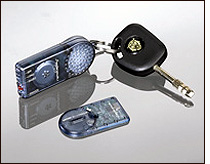Mar 20, 2006Remote Play, a company located in Lawrenceville, N.J., recently began selling TagAlert, a portable RFID device designed to emit an alarm if consumers stray too far from their cell phones, iPods, Game Boys or other mobile devices. Since late November, Sharper Image, Amazon.com and J&R Music World have carried the product, which has a suggested retail of $49 with two tags and $39 with one.
According to Ari Naim, the company’s president and CEO, the product is selling even better than expected, though he declined to reveal how many have been sold so far. The demographics of the people buying the TagAlert product, he adds, are very broad. "We're addressing the age-old problem of forgetting things," Naim says. "Everyone has an issue with forgetting a cell phone, camera, laptop, etc.,"
The TagAlert monitor, which houses an RFID interrogator (reader), is small enough to be worn on a belt clip, carabiner or key chain. Each monitor is preprogrammed to track up to two tags, sold together. Users can set the monitor to sound an alarm when a tag is more than either 15 or 75 feet away, depending on preference. Naim says the monitor's battery lasts approximately one year before it must be replaced.
The 900 MHz ultrahigh-frequency tags sold with TagAlert, Naim says, are powered by a battery with an average life of 6 months. A unique ID is encoded to each tag, and the monitor sold with the tag is programmed to search for that number. The tag runs on a replaceable lithium battery and has a strong adhesive backing to attach it to any item being tracked.
Remote Play builds its interrogators using Texas Instruments' family of MSP430 microcontrollers, which, according to Naim, offer high performance with low battery consumption. The TagAlert transceivers use spread-spectrum frequency hopping to combat other RF noise, which he claims is very important to the success of his product—perhaps even more so than for an RFID system used in the supply chain.
"An industrial or commercial setting is a much more controlled environment than general public spaces," Naim notes. In public spaces, however, "all bets are off." The interrogator needs to keep a steady eye on the tags, whether the person is on a city bus, at work or at the gym, where the RF environment is hard to predict.
Naim claims Remote Play's patented algorithms used to measure the tag's range make his product superior to a handful of other, similar products that have been on and off the market over the past few years, the users of which he says are plagued by false alarms due to interrogators losing tag signals. He claims his tags and monitor have longer battery life.
Since October 2005, Remote Play has also been selling an RFID product designed to help parents or guardians keep track of the relative whereabouts of their children or charges—in a manner some might call Orwellian. The In-Reach product, which operates in the 900 MHz band, uses the same frequency-hopping technology and algorithms as the TagAlert product, but consists of an active tag that is different than the one used for TagAlert because it supports two-way communication with the monitor. A child who is lost or in trouble can press the RFID tag's panic button, causing the monitor—carried by the parent—to issue an alarm. Alternatively, the parent can set the tag to emit an audible alarm if a child can't be located. The In-Reach monitor can track up to three such tags.
Rather than just beeping, the In-Reach monitor can be set to vibrate if the tag exceeds a given distance. Parents can set it to alert them at distances from 5 feet to 300 feet, and the monitor includes a small screen that shows the distance, though not the exact location, of the tag from the interrogator. As an adult walks in various directions, the monitor beeps or vibrates with greater or lesser intensity to indicate that the tag and child are closer or further away. This product retails for about $120 and competes with similar products such as Angel Alert.
"We've proven you can make a consumer product with RF that is reliable," says Naim, adding that most consumer feedback for the TagAlert product is based on a request to support more than two tags.


